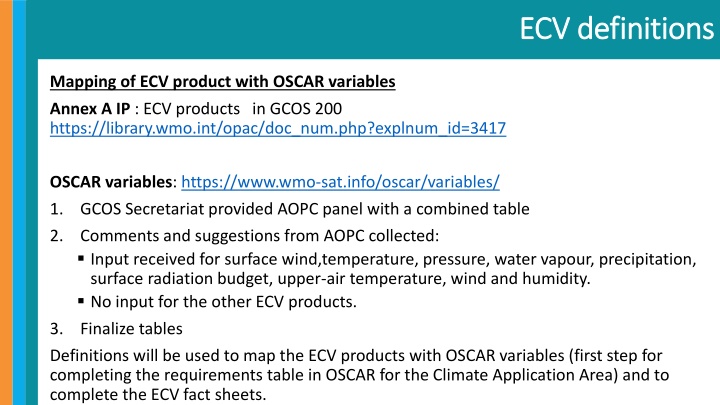Mapping of ECV Products with OSCAR Variables for Climate Applications
This document outlines the mapping of Essential Climate Variables (ECV) products with OSCAR variables, focusing on surface wind, temperature, pressure, water vapor, precipitation, and more. It includes requirements, resolutions, frequencies, and measurement uncertainties for various atmospheric ECV products. The goal is to finalize tables to facilitate the integration of ECV products into the OSCAR framework for climate applications.
Download Presentation

Please find below an Image/Link to download the presentation.
The content on the website is provided AS IS for your information and personal use only. It may not be sold, licensed, or shared on other websites without obtaining consent from the author.If you encounter any issues during the download, it is possible that the publisher has removed the file from their server.
You are allowed to download the files provided on this website for personal or commercial use, subject to the condition that they are used lawfully. All files are the property of their respective owners.
The content on the website is provided AS IS for your information and personal use only. It may not be sold, licensed, or shared on other websites without obtaining consent from the author.
E N D
Presentation Transcript
ECV definitions ECV definitions Mapping of ECV product with OSCAR variables Annex A IP : ECV products in GCOS 200 https://library.wmo.int/opac/doc_num.php?explnum_id=3417 OSCAR variables: https://www.wmo-sat.info/oscar/variables/ 1. GCOS Secretariat provided AOPC panel with a combined table 2. Comments and suggestions from AOPC collected: Input received for surface wind,temperature, pressure, water vapour, precipitation, surface radiation budget, upper-air temperature, wind and humidity. No input for the other ECV products. 3. Finalize tables Definitions will be used to map the ECV products with OSCAR variables (first step for completing the requirements table in OSCAR for the Climate Application Area) and to complete the ECV fact sheets.
IP Annex A: ECV product requirement Atmospheric ECV product requirements Resolution ECV Product Frequency Required measurement uncertainty Stability (per decade) Standards/ references Entity (see Part II, section 2.2) Satellite In situ WI GO S Surface wind speed and direction Surface wind speed and direction 3 h 10 km/NA 0.5 m/s and mean quadratic statistics to 10% of the locally prevailing mean wind speed, for speed >20 m/s 0.5 mm/h 0.05 m/s/decade For stability: WGClimate International Vector Winds Science Team Meeting (M. Bourassa) Precipitation Estimates of liquid and solid precipitation Monthly (resolving diurnal cycles and with statistics of three-hour values) 25 km/NA 0.02 mm/decade CMSAF WGClimate WI GO S requirements related to the HOAPS release 4.0 (CM-12611) P. Jones Temperature (surface) Hourly Site 0.1 K 0.02 K/decade WI GO S WI GO S Daily Tx/Tn 0.1 K
Temperatu re (upper-air) Tropospheric temperature profile Stratospheric remperature profile Temperature of deep atmospheric layers 4 h 25 km/1 km 0.5 K 0.05 K WGClimate WIGO S WIGO S WIGO S 4 h 100 km/2 km 0.5 K 0.05 K WGClimate Monthly averages 100 km/5 km 0.2 K 0.02 K WGClimate Cloud properties Cloud amount 3 h 50 km/NA 0.01 0.05 0.01/decade ESA CCI CMUG tables WGClimate Cloud-top pressure 3 h Cloud-top temperature Cloud optical depth Cloud water path (liquid and ice) Cloud effective particle radius (liquid + ice) 50 km/NA 50 km/NA 15 50h Pa 1 5 K 3 15 hPa 0.25 K/decade WGClimate WGClimate 3 h 3 h 50 km/NA 10% 2% WGClimate 3 h 50 km/NA 25% 5% 3 h 50 km/NA 1 m; 1 m/decade
OSCAR No cloud top pressure
Combined table ECV Surface Wind Speed and direction (updated by Shinya, Imke and Liz) Product Wind speed Definition Ratio of the distance covered by the air to the time taken to cover it. It is one component of wind velocity, the other being wind direction. Measured at 10m Direction from which wind is blowing, measured clockwise from north Integration of precipitation rate reaching the ground over several time intervals. The reference requirement refers to integration over 24 h Air temperature measured at 2 m above surface Meas.units m/s OSCAR variable Wind vector over the surface (horizontal) Definition Horizontal vector component (2D) of the 3D wind vector, conventionally measured at 10 m height. Wind direction Degree N Precipitation (updated by Phil) Accumulated precipitation (over 24h) mm Accumulated precipitation (over 24h) Integration of precipitation rate reaching the ground over several time intervals. The reference requirement refers to integration over 24 h Air temperature measured at 2 m above surface Temperature (surface) Air temperature (at surface) K Air temperature (at surface)
Air specific humidity (at surface)(g/kg) Air specific humidity measured at 2 m above surface. The specific humidity is the ratio between the mass of water vapour and the mass of moist air. g/kg Water vapour (surface) (updated by Roger) Air specific Air specific humidity measured at 2 m above surface. The specific humidity is the ratio between the mass of water vapour and the mass of moist air. temperature to which air must be cooled to become saturated with water vapor g/Kg humidity (at surface)( g/kg) Dew Point Temperature (no corresponding variable in OSCAR) K
Cloud Water Path (liquid and ice) LWP: A measure of the weight of the liquid water droplets in the atmosphere above a unit surface area on the earth, given in units of kg m-2 (no corresponding variable in OSCAR) Cloud liquid water (CLW) total column Field of atmospheric water in the liquid phase (precipitating or not). Cloud ice (total column) Field of atmospheric water in the solid phase (precipitating or not) as total column. Size distribution of liquid water drops, assimilated to spheres of the same volume. Considered as both a 3D field throughout the troposphere and a 2D field at the top of cloud surface. Cloud effective particle radius (liquid and ice) In OSCAR only liquid. Needs a definition m Cloud drop effective radius
Aerosols properties optical depth The AOD is the effective depth of the aerosol column from the viewpoint of radiation propagation km Aerosol Optical Depth The AOD is the effective depth of the aerosol column from the viewpoint of radiation propagation: Vertical column integral of spectral aerosol extinction coefficient AOD = exp(-K. z) where K is the extinction coefficient [km-1 ] and z the vertical path [km] single-scattering albedo Missing def (no corresponding variable in OSCAR) (no corresponding variable in OSCAR) Aerosol Extinction Coefficient layer height Missing def extinction coefficient profiles 3D field of spectral volumetric extinction cross-section of aerosol particles 3D field of spectral volumetric extinction cross-section of aerosol particles
Summary of work so far: 1. ground over several time intervals. The reference requirement refers to integration over 24 h. Unit: mm. But should we add intensity to the product? 2. Wind: keep wind speed and wind direction rather than defining as 2D vector as in OSCAR. Ask to add this in OSCAR? 3. Surface pressure, temperature ,humidity and wind: height in definition to be discussed? Both Liz and Phil made comments on the fact that observations are taken at different heights. 4. Water vapour (surface): discuss whether to suggest to keep specific humidity and dew point temperature; 5. Water vapour ( upper-air) : Specific humidity could maybe sufficient? Review the need to keep 4 layers. Roger suggests 3 layers: lower troposphere, upper troposphere and stratosphere. 6. Temperature (upper-air): Peter suggested to change the vertical layers from troposheric, stratosphertic and deep stratosphere to temperature in the BL, free troposphere, tropopause layer and stratosphere. 7. Surface Radiation Budget: Liz suggests to add upward long-wave irradiance at earth surface, wavelength range and earth surface albedo (this is already in the terrestrial ECV). Adding products will need to be discussed at AOPC Precipitation: Def: daily accumulated total: Integration of precipitation rate reaching the























